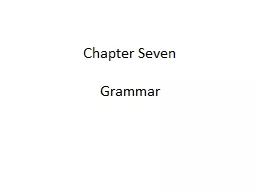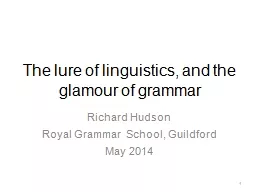PPT-Chapter Seven Grammar Introduction
Author : phoebe-click | Published Date : 2018-03-19
2 levels of description in the study of language sound sequences as represented in phonetic alphabet an described in terms of their features sequence of morphemes
Presentation Embed Code
Download Presentation
Download Presentation The PPT/PDF document "Chapter Seven Grammar Introduction" is the property of its rightful owner. Permission is granted to download and print the materials on this website for personal, non-commercial use only, and to display it on your personal computer provided you do not modify the materials and that you retain all copyright notices contained in the materials. By downloading content from our website, you accept the terms of this agreement.
Chapter Seven Grammar Introduction: Transcript
Download Rules Of Document
"Chapter Seven Grammar Introduction"The content belongs to its owner. You may download and print it for personal use, without modification, and keep all copyright notices. By downloading, you agree to these terms.
Related Documents














